To create a real forex account for free, click here
There is so much “noise” in Forex Trading that makes it difficult to discover which are the best Forex Trading tips that work.
You get stuff like Hammer, Doji, Trendlines, Breakout, Pullback, RSI, MACD, Fibonacci, Pivot Points, and etc.
How do you know what works?
How do you know what to ignore?
How do you if it’s superficial fluff that just looks good in hindsight?
You feel me?
That’s why I’ve written this post to cut through the BS and share with you 12 proven Forex trading tips that work.
And some of the things I’m about to share has never been revealed before.
So are you ready?
Then let’s begin…
Forex Trading Tips #1: The longer it range, the harder it breaks
Here’s the thing:
The market is always changing.
It moves from a range market condition to trending market, and back to range market.
And in my experience, the longer the market is in a range, the harder it breaks.
Here’s why…
When the market is in a range, traders will look to long Support and short Resistance.
And can you guess where will they put their stop loss?
Probably below Support and above Resistance.
Now…
As time passes, this cluster of stop-loss will increase as more traders fade the highs and lows of the range.
But the market has to breakout, eventually.
Now let’s say for example, the market breaks out higher.
What happens next?
Well, there are momentum traders (or Trend Followers) who goes long on the breakout. Plus, you have short traders cutting their loss (from shorting Resistance) which fuel further buying pressure.
And this leads to a strong breakout and possibly the start of a new trend.
So the bottom line is this…
The longer it range, the harder it breaks.
Forex Trading Tips #2: Volatility contraction leads to volatility expansion
This is a fact of the markets that is hardly spoken about…
Volatility contraction leads to volatility expansion.
You’re probably wondering:
“What does it mean?”
This means volatility in the market is never constant.
The markets move from a period of low volatility to high volatility, and vice versa.
Here’s an example:

Now the question is…
How can you take advantage of this phenomenon?
Well, you can use it to better time your entries, entering your trades when the market is in a low volatility period.
Why?
Because it allows you to have a tighter stop loss, thereby allowing you to increase your position size (for the same level of risk).
And if volatility expands in your favor, you’re already in the trade — while other traders are trying to “chase” the markets.
And this brings me to my 3rd Forex trading tip…
Forex Trading Tips #3: Trade breakouts with a buildup
You’re probably wondering:
“What is buildup?”
A build-up is a tight consolidation otherwise known as volatility contraction.
And the location where a buildup occurs gives you a BIG clue to where the market is likely to break out.
For example, if there’s a buildup formed at Resistance, the market is likely to breakout higher.
Let me explain…
You know Resistance is an area to short the markets (after all the textbook says buy Support and sell Resistance).
But what if you go short Resistance and the price is still hovering at that area.
What does it tell you?
To an amateur price action trader, they will think Resistance is getting stronger as the price fails to break above it.
But…
To the seasoned price action trader, this is a sign of strength from the buyers.
Why?
Because if there is a strong selling pressure, the price should move quickly away from Resistance.
The fact that price is still at Resistance is telling you there are buyers willing to buy at higher prices — and that’s a sign of strength.
And that’s not all…
When the price breaks above Resistance, it will trigger a cluster of stop-loss (from traders who are short) which fuels buying pressure.
Plus, breakout traders will long the break of the highs which adds strength to the move.
An example:
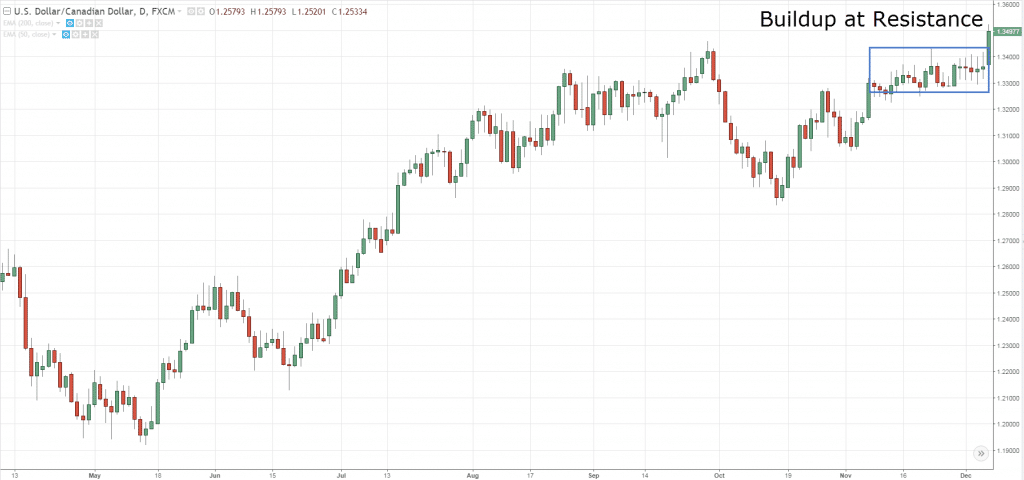
So…
Whenever you see buildup form at Resistance, it’s likely the price will breakout higher (and vice versa for Support).
Continue reading…
Forex Trading Tips #4: Higher lows into Resistance is a sign of strength
Old Rayner: “Oh look! The price is coming to Resistance, time to short this market.”
New Rayner: “Not so fast…”
Here’s the thing:
You don’t go short just because the price is at Resistance.
Why?
Because how the price approaches Resistance matters a lot.
For example, if you see higher lows coming into Resistance, it’s a sign of strength.
It tells you the buyers are willing to buy at higher prices and the sellers are unable to push price lower (than it did previously).
And this looks like an Ascending Triangle on your chart:
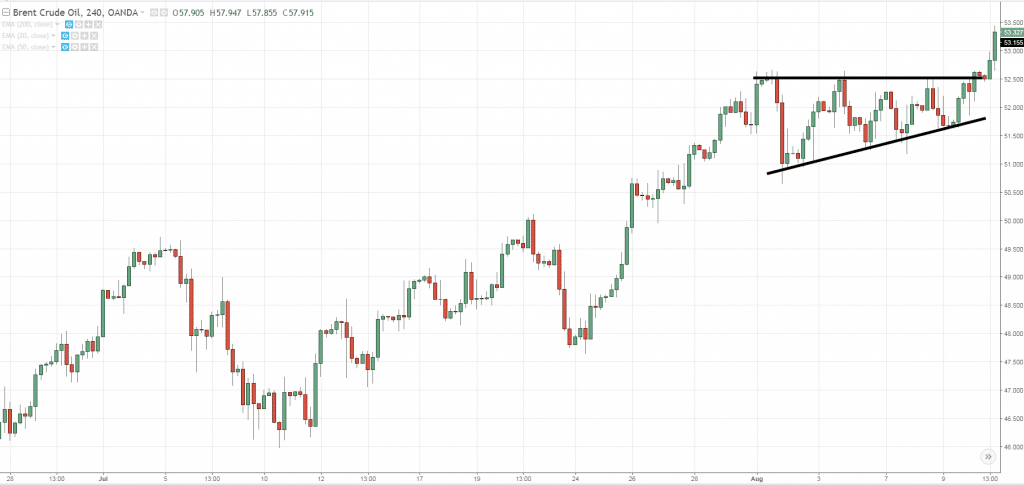
Can you see the higher lows approaching Resistance?
That is a sign of strength.
And more often than not, the price breaks out higher.
Let’s move on…
Forex Trading Tips #5: Lower highs into Support is a sign of weakness
If you’ve read what I’ve said earlier, then this is a no-brainer (though most traders don’t get it).
So…
Why are lower highs into Support a sign of weakness?
Because it tells you the buyers are unable to push the price beyond the previous swing high.
Here’s why:
If the buying pressure is strong, it should have no problem breaking above the previous highs.
If it can’t, it means there is a stronger selling pressure and sellers are willing to sell at lower prices.
And this looks like a Descending triangle on your charts…
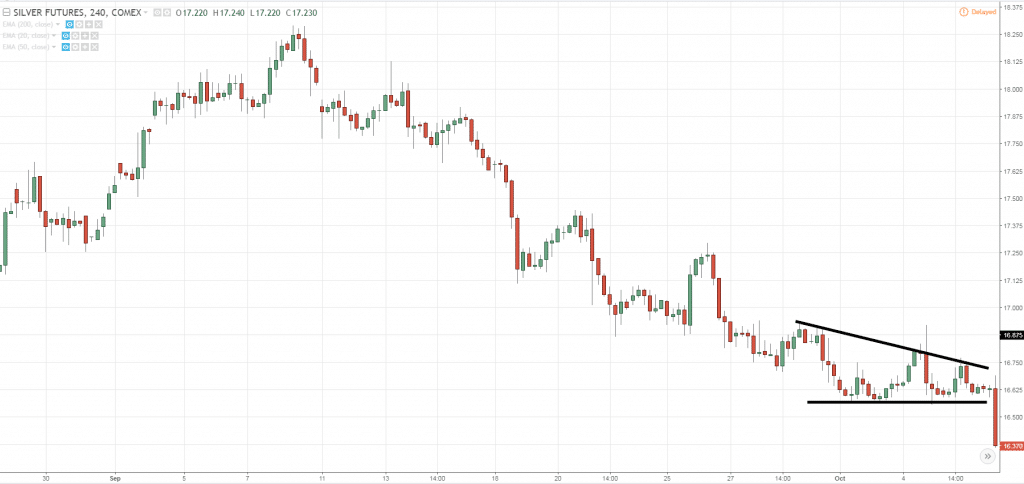
Now:
When most traders see the price approaching Support, they’ll get long.
But you’re smarter now.
You’ll analyze how the price approaches Support.
And if it forms lower highs into Support, you’ll leave it to those amateurs to go long — only to get stopped out.
Onward…
How to find low risk and high reward trading setups
Here’s the thing:
Most traders enter their trades when the price is in the middle of nowhere.
It doesn’t make because there is no logical place for you to put your stop loss.
Even if there is, it’s usually wide and this results in a poor risk to reward setup.
But don’t worry, there’s an easy solution.
And if you can do it, you’ll see a huge difference in your results.
Want to know what’s the secret?
Well, it’s to enter your trades close to Support and Resistance and then leaning your stop loss against it.
Here’s what I mean: A poor risk to reward trading setup…
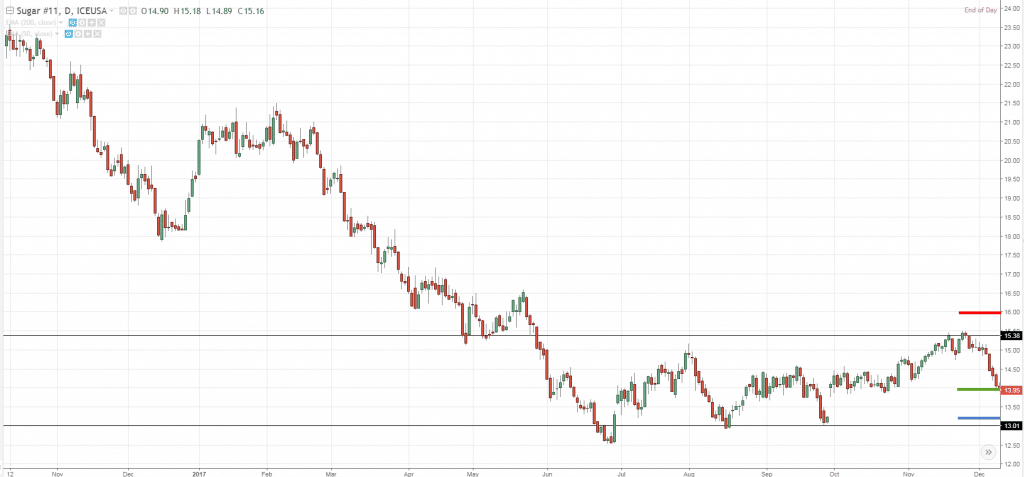
This is a much more favorable risk to reward setup…
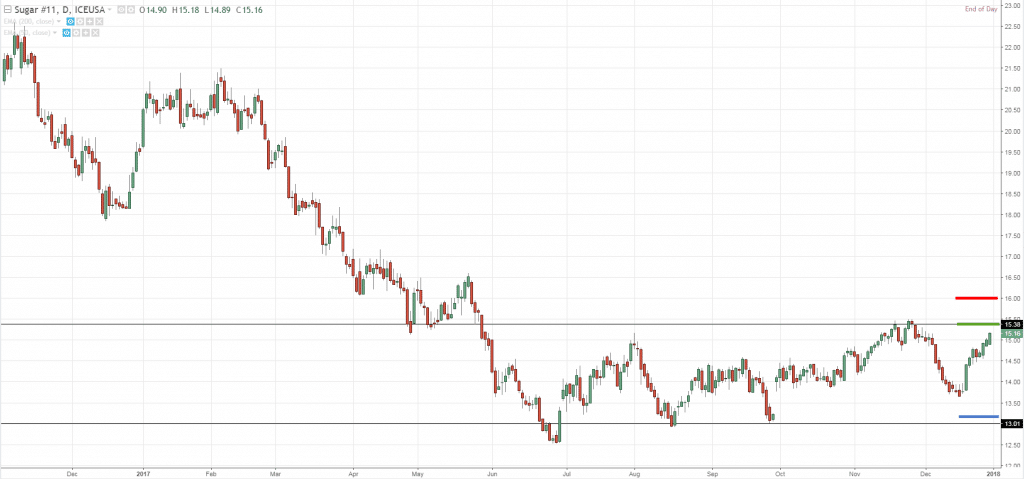
Green = Entry
Red = Stop loss
Blue = Target Profit
See the difference?
You have the same target profit in both scenarios, but a huge difference in potential risk to reward.
Pro Tip:
Use a trading alert to inform you when the price has reached your desired level. So you don’t have to spend all day in front of your monitor.
If you want to know how to do it, TradingView has one such feature.
Don’t put your stop loss at the same place as everyone else. Here’s what you should do instead…
Let me ask you…
Do you always get stopped out, only to see the market reverse back in your direction?
Well, that’s because you place your stop loss at the same level as everyone else, and this gives the smart money an incentive to hunt your stop loss.
So what can you do?
Simple.
Don’t put your stop loss at an obvious level.
Now you’re probably wondering:
“So where should I set my stop loss?”
Well, the trick is this…
Identify the level on your chart where it’ll invalidate your trading setup — and give your stop loss a buffer away from the level.
Let me explain…
Most traders place their stop loss below Support and above Resistance (after all that’s what the textbooks and courses tell you to do).
But the problem with this is that’s where everyone else places their stop loss — which makes it easy for you to get stop hunted.
Instead, a better way is to set your stop loss a buffer away from Support and Resistance, away from the noise of the markets (or everyone else).
An example:
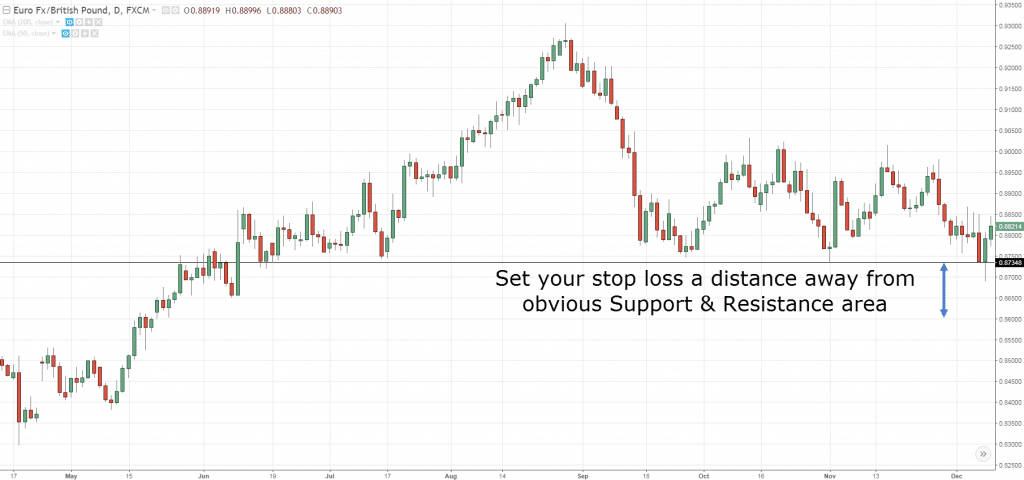
And this same concept applies to Trendline, moving average, and etc.
If you want to learn more, go watch this training video below that shows you how to set a proper stop loss (step by step)…
Trading with the trend gives you bigger profits
It baffles me whenever I see traders trading against the trend.
Why would you want to do that?
Perhaps it’s an ego thing, to call market tops and bottoms. But here’s the thing…
If you’re serious about making money in this business, it’s far easier to trade with the trend — not against it.
Let me explain…
A trending market typically has 2 types of move; a trending move and retracement move.
The trending move – this is the stronger “leg” as it moves in the direction of the trend (and sometimes with strong momentum). This means it’s easy to stay in this type of trade as the market usually moves in your favor quickly.
The retracement move – this is the weaker “leg” as it moves against the direction of the trend. You can trade this type of move, but it’s more stressful as the market could quickly reverse against you.
Now, look at this chart below…
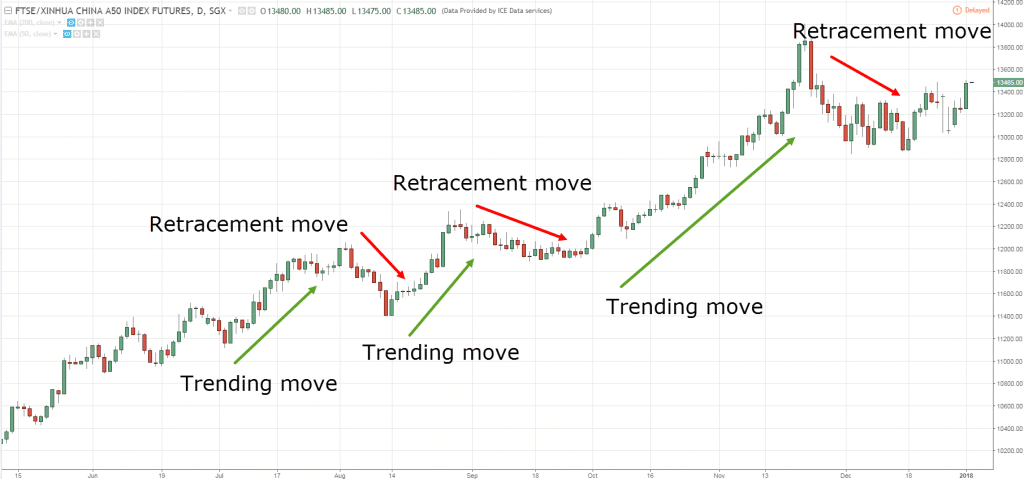
Do you want to trade the trending move or retracement move?
The choice is yours.
This is one simple trick that improves your risk to reward on every trade…
Now, correct me if I’m wrong…
But whenever you put on a trade, you look for at least 1 to 2 risk to reward ratio, right?
But here’s the thing…
If you’re the type of trader who waits for confirmation before entry, the candle might “close too much” in your favor (which offers a poor risk to reward ratio).
Before you know it, you are entering your trade right smack into Support and Resistance.
So, what can you do?
Well, there’s a simple solution to it.
Use a limit order.
Yes, use a limit order for your entry so you can enter your trades at a much favorable price (instead of “chasing” the markets).
An example:
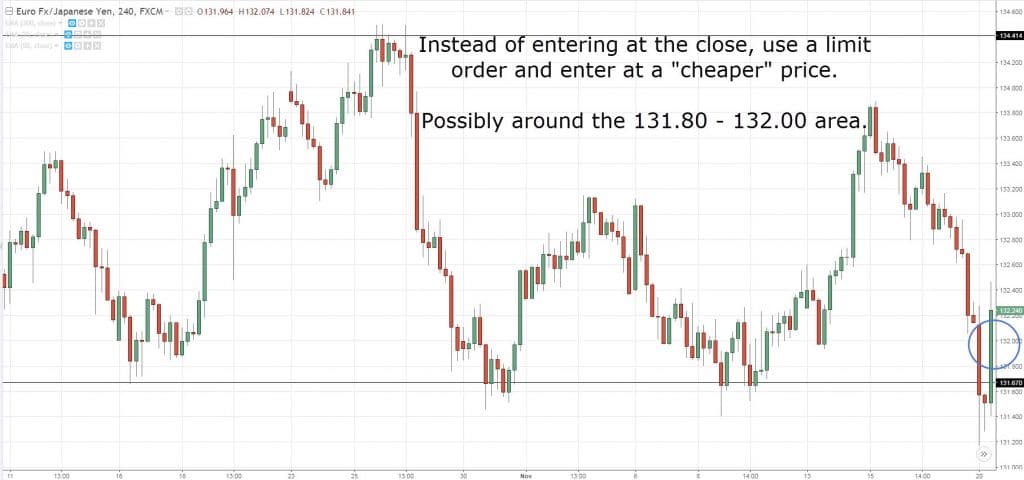
Pro Tip:
One way to set your limit orders is in front of Support or Resistance, swing highs or lows, to increase your odds of getting filled.
The best pullback is the first pullback
A pullback is when the price temporarily moves against the trend. And this provides an opportunity for traders to get on board the trend.
In my experience, the best pullback is the first pullback after a breakout.
Here’s why…
When the market is in a range, it must break out eventually.
And as you know… the longer it range, the harder it breaks.
So, when the market finally breaks out, traders who miss the move can’t wait to enter on the first sign of a pullback.
These pullbacks usually have shallow retracement as not many traders want to trade against the strong momentum.
And this offers a high probability pullback trade.
Here’s what I mean:
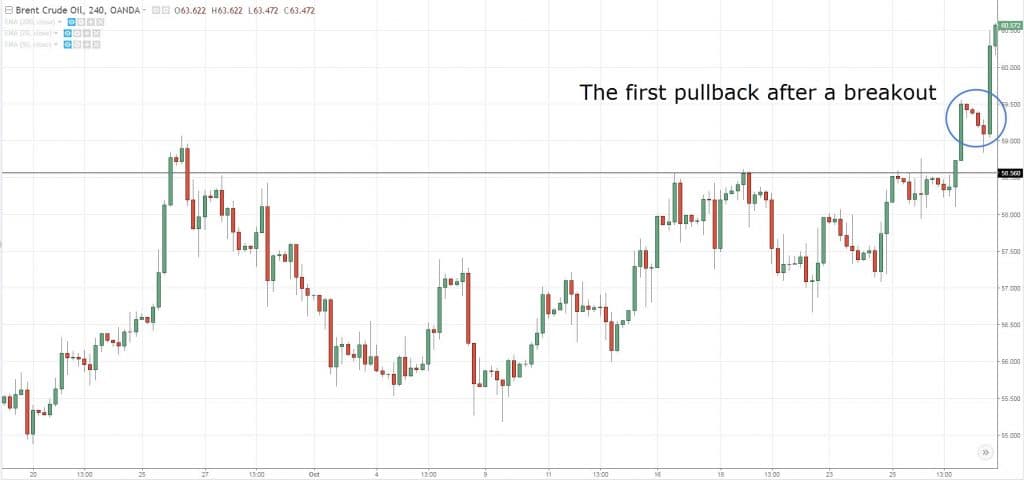
Now you’re wondering:
“How do I find such high probability pullback trades?”
Simple.
Just follow this 3 step process:
- Identify markets which are in a range
- Let the market breakout
- Trade the first pullback
Cool? Then let’s move on…
The market is unlikely re-test the levels you’re looking at
Has this ever happened to you?
You noticed the market has broken out higher and you’re not in the trade.
So, you tell yourself…
“I’ll look to go long when the price re-tests previous Resistance turned Support”.
And of course, the market never returns back to the level and continues trading higher.
Why?
Because when the whole world expects the price to “test” a level, it probably won’t.
And even if it does, it will attempt to shake out as many traders as possible before continuing its move.
It stinks, right?
I know.
Now you’re wondering:
“Is there anything I can I do about it?”
Of course!
Here are 3 techniques you can use:
- If the market doesn’t re-test your level, look to trade the next breakout
- If the market doesn’t re-test your level, anticipate a new range to form and trade the highs/lows of it
- If the market re-test your level, let it show signs of reversal before entry
Let me explain…
1. Trade the next breakout
Now…
If you agree that the market seldom comes back to re-test your level, then it makes sense to enter your trade on the breakout, right?
This means you’re anticipating a bullish flag pattern to form and to trade the break of it.
An example (bearish flag):
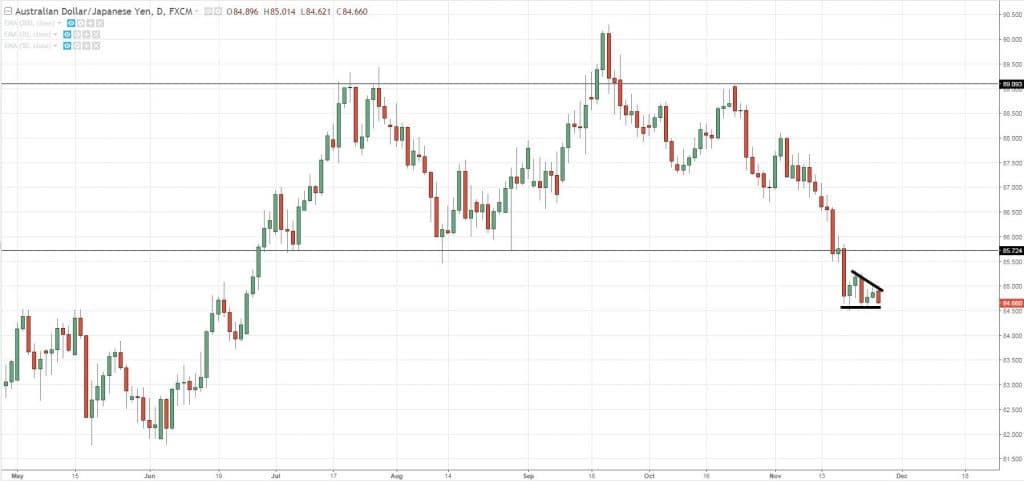
Next…
2. Anticipate a new range to form and trade the highs/lows of it
Here’s the thing:
Sometimes the market may not breakout and neither does it re-test the level you’re looking at.
Instead… it forms a new range.
So, what can you do?
Well, you take advantage of it by trading the range.
This means in an uptrend, you’ll get long near the lows (of the new range), with the possibility the market will break out of the highs.
3. Let it show signs of reversal before entry
As mentioned earlier, even if the market comes back and re-test a level, it’ll attempt to shake out as many traders as possible.
This means the market can retrace much deeper than you expect, and shake you out of your trade before it reverses back in your direction.
So, what’s the solution?
Simple.
Let the market show signs of reversal before establishing an entry.
Now you might get a later entry, but it improves your win rate (which helps your trading psychology).
Moving on…
How to profit from the False Breakout pattern
Has this ever happened to you?
You noticed the market broke out of the highs and you think to yourself…
“This breakout is real. Just look at the HUGE bullish green candle.”
So, you immediately go long… hoping to catch a BIG move.
But shortly after you entered the trade, the market reverses in the opposite direction!
And it doesn’t take long before you get stopped out of your trade.
Here’s what I mean…
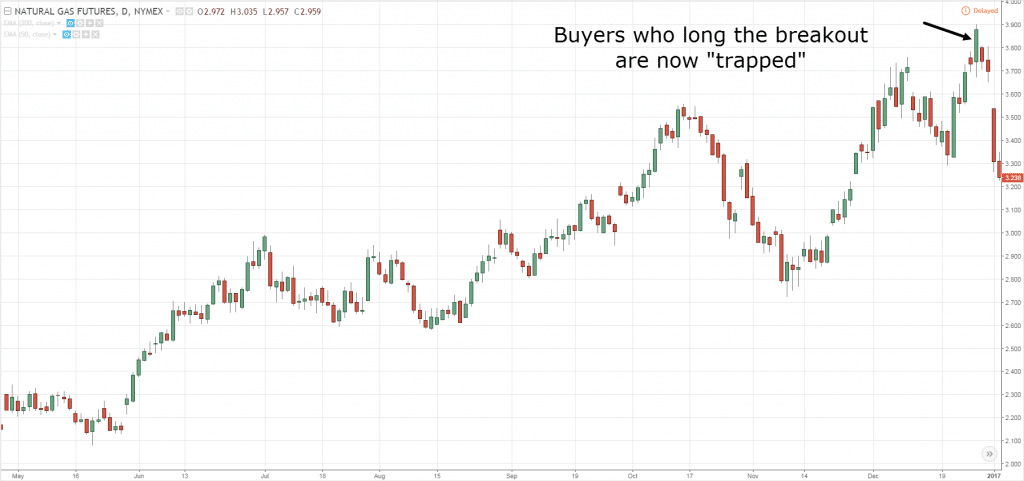
So, what just happened?
Well, I call this a False Breakout.
It’s when you trade a breakout only to get “trapped” and have the market reverse against you.
Now you’re probably wondering:
“How can I profit from the False Breakout?”
Here’s how:
- Identify the key Support and Resistance where traders will look to trade the breakout
- Wait for the breakout to fail when the price trades back into the range
- Trade in the direction of the False Breakout
Let me show you an example:
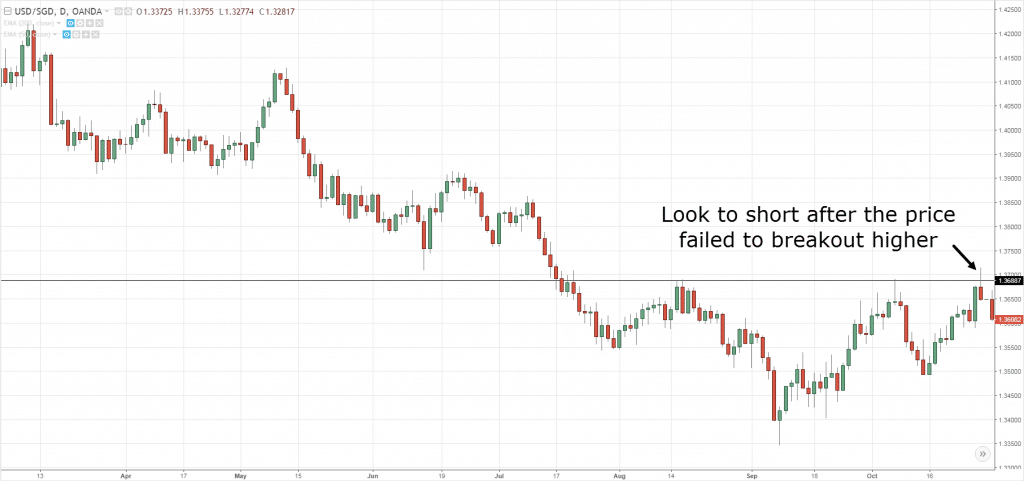
This is powerful stuff, right?
Conclusion
As a recap, these are the 12 Forex trading tips you’ve learned:
- The longer the market is in a range, the stronger the later breakout
- A contraction in volatility leads to an expansion in volatility
- Breakouts with buildup have a higher probability of success
- The Ascending triangle pattern is a sign of strength
- The Descending triangle pattern is a sign of weakness
- Trading close to Support and Resistance offers favorable risk to reward on your trade
- Don’t place your stop loss just beyond Support and Resistance, give it some “buffer”
- Trading with the trend offers a greater profit potential
- You can use a limit order and improve your risk to reward
- The first pullback is the best pullback
- If the market doesn’t re-test the level you’re looking at, you can 1) trade the breakout 2) trade the new range that’s formed 3) let it show signs of reversal before entry
- The False Breakout is a profitable pattern to trade
Great post. Do you have any other ones you can drop? I like it. I have actually tried Dux Forex as a signals provider and they are amazing. I will keep you guys posted. 🙂
It’s an amazing piece of writing in favor of all the online
users; they will take advantage from it
I am sure.
Hi there every one, here every person is sharing these experience, thus it’s nice
to read this webpage, and I used to go to see this website every day.
Appreciate this post. Will try it out.
I enjoy what you guys are usually up too. Such clever work and coverage!
Keep up the excellent works guys I’ve incorporated you guys to blogroll.
You are so awesome! I don’t suppose I’ve read a single thing
like this before. So wonderful to discover someone
with original thoughts on this topic. Really.. many thanks for
starting this up. This site is something that is needed on the internet, someone with a
little originality!
My brother suggested I may like this web site. He was once entirely right.
This submit truly made my day. You cann’t believe just how much time
I had spent for this information! Thank you!
Great blog you have got here.. It’s hard to find good quality writing like yours these days.
I really appreciate individuals like you! Take
care!!
Very energetic article, I liked that a lot. Will there be a part 2?
Hi friends, its enormous article about educationand fully explained, keep it
up all the time.
This design is incredible! You most certainly know how to keep a reader amused.
Between your wit and your videos, I was almost moved to
start my own blog (well, almost…HaHa!) Great job. I really loved what you had to say,
and more than that, how you presented it. Too cool!
Like!! I blog quite often and I genuinely thank you for your information. The article has truly peaked my interest.
Thank you for every other informative blog. Where else may just I
am getting that type of information written in such an ideal means?
I’ve a mission that I’m just now operating on, and
I have been at the glance out for such info.
Here is my webpage LanceUKenyon
Unquestionably believe that that you simply said.
Your favourite justification appeared to be in the net the easiest thing to keep in mind of.
I have faith that to you personally, I certainly get annoyed as well as people consider worries that they
can plainly usually do not realize about. You managed going to
the nail upon the best plus defined out the whole thing
without having side-effect , people could take
a signal. Will likely be again to obtain more.
Thank you
my site :: LorrieQEmayo
It’s hard to find educated people on this topic, but
you seem like you know what you’re talking about! Thanks